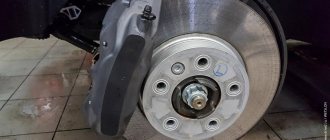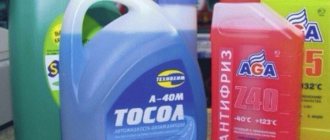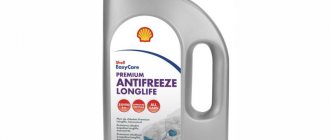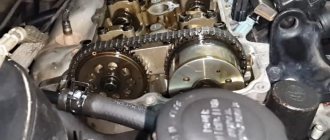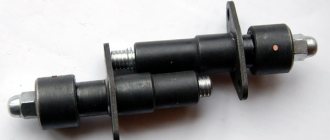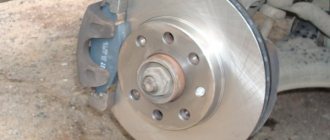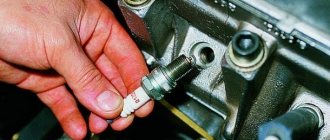Reading time: 7 minutes. .3k.
Let's take a closer look
- Stages of replacing coolant VAZ 2107
- Coolant drain
- Flushing the cooling system
- Filling without air pockets
- Replacement frequency, what antifreeze to fill
- How much antifreeze is in the cooling system, volume table
- Leaks and problems
- Video
A classic of the Soviet automobile industry, the VAZ 2107 (seven), has earned the love of car enthusiasts as a cheap car to maintain. Most often, owners try to carry out repairs and maintenance themselves. Replacing antifreeze is one of these maintenance operations, which you can also do yourself if you follow the instructions.
Why do they change antifreeze?
The cooling system of many modern cars is liquid. That is, heat transfer is carried out by a liquid that circulates through a system of tubes and, cooling in the radiator, returns back to the engine to receive a new portion of heat. The VAZ 2107 engine cooling system initially used water, but later, due to reduced resistance to negative temperatures, it was replaced with antifreeze.
Antifreeze, compared to water, has good resistance to frost and does not freeze at all. In addition, it is not a source of scale, which means it does not clog the cooling system.
In the process of constant temperature exposure, antifreeze may lose its properties. That is, first of all, its boiling point decreases and becomes equal to the boiling point of ordinary water. Secondly, such fluid can easily freeze and cause a cracked reservoir, and in the worst case, a cracked cylinder block. That is why antifreeze must be changed at least once every six months during seasonal vehicle maintenance in order to avoid undesirable consequences.
This is interesting: What kind of oil is poured into the Hyundai Creta
How to fill
You will need the entire previous list of tools, with which you can safely proceed to the second part.
- Tighten the bolt.
- Now fill the radiator with fluid up to the top mark.
- Remove the expansion tank hose and also fill it with liquid. Lift it up and start pouring further, so that it comes out through the other end of the hose. We put the hose back on the radiator. Let's add more.
Lift the reservoir up and add liquid
- Turn on the engine and wait for the fan to start working.
- Turn off the engine and check the level.
- We tighten the radiator cap and the expansion tank cap. And put the lid back in place. Close the hood.
Done, replacement of antifreeze in the VAZ 2107 has been successfully completed.
Antifreeze volume in the car
The first thing you need to know is how much antifreeze can be poured into a VAZ 2107 so that it works stably. For cars of brands such as VAZ 2101, 2105, 2106 and VAZ 2107, the volume of fluid is the same - 9.85 liters, it must be replaced every two years. Replacing antifreeze on a VAZ 2107 occurs in the following way:
- The first thing you need to pay attention to is the cooling system; if it is clogged, it needs to be washed with special products or water.
- Next, you need to take a spanner wrench and a container of at least ten liters to drain the old car fluid. It is very important that the radiator is cold when replacing, since antifreeze is a harmful substance, and when heated it also becomes very toxic.
The volume of coolant in a VAZ 2107 can reach up to ten liters. Antifreeze is suitable for the engine cooling system, as it prevents heat from entering the engine and cools the radiator. The cooled antifreeze is moved to the car engine using a pump. This process continues until engine operation stops. During operation, antifreeze heats up and loses its positive properties, so it must be changed periodically. The process of heating the antifreeze occurs when the car travels a distance of about 60 thousand kilometers.
Fill
Carefully pour antifreeze into the hole. A signal that the required amount has been filled will be the flow of liquid from the fitting. We put the hose in place, tighten the clamp
, after which we ensure that the radiator and expansion tank are filled (the recommended level is the central position between the maximum and minimum marks).
Having completed the filling process and securely closed all the holes, be sure to start the engine, bringing it to a temperature of 70-90°C. We check the fluid level in the expansion tank
(you may have to add a little antifreeze).
The process described above is quite simple and unpretentious - after one or two times it is performed “automatically”, without additional advice or minute-by-minute checks with the instructions. Replacing antifreeze on a VAZ 2107 is quite possible even for those who have a very vague idea of what is under the hood of the car. The main thing is to carry out all manipulations in strict accordance with the recommendations, step by step, alternating actions in the required sequence.
Instructions for replacing antifreeze
Antifreeze, compared to water, is quite resistant to frost - it does not freeze. It is also not a source of scale, which means it does not clog the cooling system.
But, subjected to constant temperature influences and fluctuations, antifreeze loses its properties during operation:
- the boiling point decreases and accordingly becomes equal to the boiling point of water;
- The fluid may freeze, resulting in a cracked reservoir or cracked cylinder block.
For these reasons, it is necessary to change antifreeze at least once every six months. It is important to do this during seasonal car maintenance. Timely replacement of coolant will help avoid unpleasant consequences, unwanted repairs and unnecessary waste of money.
So, replacing antifreeze on a VAZ 2107 includes draining the antifreeze, flushing the cooling system (if necessary) and replacing the used coolant with new antifreeze or antifreeze.
You should first prepare the following materials and tools:
- canister with new antifreeze (6 liters);
- funnel;
- wrench “13”;
- open-end wrench “16”;
- key “12”;
- an empty container of 6-10 liters (a cut canister is often used);
- a clean rag made from natural fabrics;
- Protect your hands with gloves.
Drain
Draining antifreeze from the VAZ 2107 tank includes the following sequence of actions:
- Place the car on the inspection hole so that the front wheels of the car are higher than the rear ones;
- Move the lever (located on the dashboard) that supplies warm air into the cabin as far as possible to the right;
- Open the hood and unscrew the expansion tank cap;
- Unscrew the central radiator cap;
- Using a 16mm open-end wrench, unscrew the drain plug located on the cylinder block. Place a container prepared in advance, as liquid will begin to pour out. It may take up to 10 minutes to completely drain the spent fluid;
- Using a “12” wrench, unscrew the plug on the radiator drain hole, located in its lower part. A special bucket or container is used for draining;
- Remove the belt holding the expansion tank by hand. You should raise the tank as high as possible, thus draining the remaining antifreeze from the hose connected to the tank;
- After completing the procedure for draining antifreeze or antifreeze, the tank is installed in place, all drain holes are then closed and the cooling system must be flushed.
Flushing
Flushing the cooling system is an important procedure. It determines how effectively the VAZ 2107 engine will be cooled. A number of car owners believe that flushing the cooling system is a waste of time, and immediately fill in new antifreeze or antifreeze after draining the used fluid. This causes clean and dirty fluid to mix, negatively affecting performance.
You can flush the cooling system using either water or special products.
Cleaning OS with water
Flushing the cooling system with water is only allowed if there is no flushing liquid. The fact is that ordinary water contains impurities that contribute to the formation of scale. If the choice is water, it is better to use distilled water.
Sequencing:
- Water is poured into the expansion tank of a VAZ 2107;
- Let the engine idle for 30 minutes;
- After half an hour has passed, the engine is turned off and the water is drained;
- Repeat the procedure until the water drained from the system is as clean as the water being poured in;
- Stop the procedure after clear water appears.
Cleaning the OS with a special agent
You can also flush the cooling system with a product containing special impurities. This is a more expensive way to clean the system, but in the long term the most appropriate option, since the product removes from the tank:
- fat deposits;
- dissolves and removes scale from the tank;
- organic compounds.
Today, VAZ 2107 car owners use flushing fluids, the two main components of which are acids and alkalis. Car owners prefer LAVR, which costs from 700 rubles.
The sequence of actions when flushing the cooling system with a special liquid is no different from flushing with water. The only significant difference is the operating time of the motor, which is indicated on the canister of liquid.
After flushing the radiator tubes of a VAZ 2107 with LAVR, the positive result is obvious.
Bay
After the actions have been taken, it is time to fill in new antifreeze (or antifreeze, if such a decision was made by the VAZ 2107 car owner).
How to replace antifreeze on a VAZ 2107 injector? Sequencing:
- Open the radiator cap and insert a funnel into it;
- The following actions are carried out with the help of a partner. The plug is removed from the cylinder block and antifreeze is slowly poured in. At the same time, tighten the bolt, and as soon as the antifreeze flows out of the BC, the bolt is tightened. Such a maneuver will help eliminate the creation of air jams;
- Pour antifreeze into the radiator until it is completely filled;
- Pour antifreeze into the expansion tank until it reaches the radiator. Then screw on the tank cap;
- The tank is the last to be filled. The level corresponds to the norm. Upon completion of all procedures, the lid is screwed on;
- Start the engine and warm it up to operating temperature to check the proper operation of the cooling system. The cooling fan should work and the temperature should drop, which means the system is in working order.
This completes the replacement of antifreeze in the VAZ 2107 injector. There is no need for special knowledge or special equipment to perform this procedure. It is enough to have a set of tools and decide on a place.
You should also pay attention to the fact that antifreeze, like antifreeze, is a toxic substance. Consequently, a number of safety measures are observed when replacing coolant on a VAZ 2107:
- Do not dump antifreeze on the floor in the garage or on the ground in the yard. The liquid is poisonous and can harm the human respiratory system;
- Protect your skin and do not allow antifreeze to get on your hands or in your mouth. A number of motorists check the nature of the fluid used by dipping their finger into the reservoir. The consequences may be poisoning or burns;
- If antifreeze gets on your hands, face, eyes, or mouth, rinse with a stream of cold water and take the victim to a specialist, or call an ambulance. Antifreeze, like antifreeze, is first of all a liquid hazardous to health, and only then a necessary component for the proper operation of a VAZ 2107 car;
- Do not have a snack while working on replacing antifreeze in the VAZ 2107. In this way, you can swallow the evaporated toxic liquid;
- Wash your hands after completing the antifreeze replacement procedure. This is done several times with running water, after which the skin should be protected with a special cream (especially important if antifreeze gets on the skin of your hands).
By adhering to the described recommendations, the driver of a VAZ 2107 car will protect both himself and others from unpleasant consequences, poisoning, burns, etc.
Flushing the cooling system
Flushing the cooling system is a very important procedure, since the cooling efficiency of the VAZ 2107 engine depends on it. At the same time, many car enthusiasts prefer not to flush the cooling system, but to fill in new antifreeze immediately after draining the old one. As a result, the remnants of the old antifreeze are mixed with the new coolant, which has an extremely negative effect on its performance. That is why it is strongly recommended to flush the engine cooling system before adding new antifreeze. This can be done either with water or with the help of special compounds.
Flushing the cooling system with water
It should be said right away that it is advisable to use this washing option only when there is no good washing liquid at hand. The fact is that ordinary water contains impurities that form scale. And if the driver still decides to flush the cooling system with water, then the best choice in this situation would be distilled water.
Water rinsing sequence
- Distilled water is poured into the expansion tank of the VAZ 2107.
Distilled water is poured into the expansion tank of the VAZ 2107
- The engine starts and idles for half an hour.
- After this time, the engine is turned off and the water is drained.
The water drained from the VAZ 2107 must be as clean as the water being poured
- After this, a new portion of water is poured into the tank, the engine starts again, runs for half an hour, then the water is drained.
- The procedure is repeated until the water drained from the system becomes as clean as the water being poured. Once clean water appears, washing stops.
Flushing the cooling system with a special compound
Flushing the cooling system with a special composition is the best, but also very expensive option. Because cleaning products effectively remove residual grease, scale and organic compounds from the system. Currently, VAZ 2107 owners use two-component flushing fluids, which contain both acids and alkalis. The most popular liquid is LAVR. Cost - from 700 rubles.
LAVR flushing fluid is the optimal choice for flushing the VAZ 2107 cooling system
Sequence of flushing the system with a special liquid
The sequence of flushing the cooling system with a special composition is practically no different from the sequence of water flushing mentioned above. The only difference is the operating time of the motor. This time must be clarified (it depends on the composition of the selected flushing liquid and must be indicated on the canister with flushing).
Comparison of VAZ 2107 radiator tubes before and after flushing with LAVR
Lack of fluid and consequences
The disadvantage of antifreeze is rapid evaporation; you also have to solve the problem of leakage.
It happens that liquid can be seen leaking under the car. There are also cases when it goes into the car interior, this indicates a breakdown of the heater taps, they need to be replaced. In addition, smoke may be emitted from the exhaust pipe. This occurs due to a faulty cylinder head gasket. When antifreeze boils, you need to fix the problem in time ; you need to drain it and change it.
If you do not give significance to the signs that appear and continue to move on, then the consequences can be very sad. If the fluid disappears from the tank, the motor may overheat when the mark reaches the minimum value.
This is interesting: How to distinguish counterfeit Shell motor oil
The thermostat is the boss
Not a very pleasant breakdown, especially if it happens on the road. And if the engine is boiling due to a faulty thermostat, then there is only one way out - to change this element of the system. True, at first you can slightly “reanimate” him; for this you need to apply several sharp blows to his body with something heavy.
But such a “rough” solution may not always help. There will be much more trouble if liquid leaks out of the tank. The thermostat allows the system to switch the circulation of liquid between two circles - large and small. These circles differ in that in the first one a radiator is connected to the cooling process. And if it does not connect, then the liquid boils.
On VAZ 2107 cars, and indeed on all cars of this manufacturer, the thermostat fails in such a way that the antifreeze continues to circulate in a small circle. And even if you turn on the radiator fan with the button, this will not save the situation.
The car still drives poorly, the antifreeze boils, and you won’t be able to immediately understand why this is happening. And the answer is very simple - to increase the life of the thermostat, do not pour running water into the system. Use any antifreeze, in particular antifreeze. The water leaves a large amount of scale, which interferes with the movement of the thermostat element.
Timing for replacing coolant in VAZ 2107
The purpose of the coolant in the VAZ 2107 is to remove excess heat from the car’s engine. Indeed, during operation, many parts of an internal combustion engine reach temperatures of 300 degrees C. If the engine is not cooled in time and sufficiently, it will fail. Coolant solves this problem; it is supplied to a running engine, flows through the channels, thus taking away excess heat from the internal combustion engine.
After heating, the coolant goes into the central radiator, which is constantly blown by the fan. After cooling in this unit, the liquid returns to the engine cooling channels. This is the procedure for continuous liquid cooling of the VAZ 2107 engine.
The general principle of operation of the VAZ 2107 cooling system can be studied using the diagram below.
How to understand what kind of coolant is required for a VAZ 2107 - antifreeze or antifreeze? Since we are talking about Russian cars, we should distinguish between concepts such as antifreeze and antifreeze to clarify concepts.
It should be noted that such division and differentiation is accepted only in the Russian Federation. To answer this question, you must first understand: what is coolant?
So, the basis of the coolant is ethylene glycol, less often propylene glycol. Special additives are added to it, which protect against corrosion. Each manufacturer adds different types of additives.
Let us differentiate the coolants available on the modern market according to additive production technologies:
- traditional, in which additives are made from salts of inorganic acids: silicates, nitrites, amines, phosphates;
- carboxylate, additives are made from organic carbonates;
- hybrid, consists of a mixture of organic carbonate additives and inorganic salts (in smaller quantities, including phosphates or silicates).
So, the main difference between antifreeze and antifreeze is that coolant made using traditional technology is called antifreeze, while coolant made using carboxylate technology is called antifreeze.
Advantages and disadvantages of using antifreeze
Pros:
- protective film. Thanks to the inorganic salts contained in antifreeze, a protective film is created on the surface of the cooled parts, protecting them from corrosion. The film reaches 0.5 mm. In the picture below you can see how antifreeze creates a protective layer, the disadvantage is that it interferes with heat removal;
- color change. If the driver forgot to change the coolant, a clue to the need for the procedure will be the color of the liquid, which is easy to notice just by looking into the car's expansion tank. The changes are that as the antifreeze loses its useful properties it becomes darker, and completely unusable antifreeze cannot be distinguished from tar;
- affordable prices. Coolant produced using traditional technology is 3 times cheaper than antifreeze.
Disadvantages of antifreeze:
- replacement frequency. Antifreeze has a short lifespan, becoming unusable after 50 thousand kilometers;
- negative impact on aluminum parts. The additives used to create antifreeze negatively affect the aluminum surfaces in the main radiator (which significantly reduces its service life);
- due to the tendency to form condensation, it negatively affects the water pump of the VAZ 2107, as a result - premature wear of its impeller.
Let's look at the advantages and disadvantages of using antifreeze
Pros:
- service life is longer - 6 liters of antifreeze is enough for 150 thousand kilometers;
- temperature selectivity - due to the presence of carbonate additives, antifreeze more actively protects the engine surface that is heated the most;
- antifreeze does not interfere with heat dissipation, and also protects corrosion areas with the help of local layers;
- long engine operation due to temperature selectivity and timely engine cooling with antifreeze;
- there is no condensation, which means antifreeze cannot damage the radiator and water pump of the VAZ 2107.
The disadvantage of antifreeze is obvious - its high cost. In terms of price, it is on average 3 times higher than antifreeze.
Principle of operation
The main place in a car is not the driver’s seat or even the steering wheel, but the engine. It is even called the heart. And this is not without reason, because the correct functioning of this heart directly determines whether the car will go or not. And in order not to destroy such an important technical unit, it is necessary to maintain a certain temperature and cool it in time.
The operating principle of this system is quite simple, but at the same time technically well thought out. It is connected by pipes to the engine itself, the radiator and the interior heater
To understand the importance of these elements, you need to know their main functions:
- Maintaining the required temperature.
- Engine cooling.
- Warming up the car interior.
In the first case, for engine operation and proper combustion of the fuel mixture, a certain and stable temperature is required. If it is higher or lower, it has a very bad effect on the engine. In the second case, the engine is protected from overheating, which can lead to deformation of some parts inside.
Types of coolants
To absorb heat and remove it from hot spots in the engine, the system requires coolant. There are several types of cooling liquids:
- Water.
- Antifreeze.
- Antifreeze.
But in the harsh realities of the Russian climate, the use of water as a coolant is impractical. And it boils away very quickly, having a rather low thermal conductivity. You don’t even need to mention how it affects the occurrence of corrosion.
Antifreeze is the most common among domestic car owners, but it has some disadvantages, for example, the formation of an oil film inside the vessels and pipes, which prevents normal heat transfer. Accordingly, heat removal becomes ineffective.
The third option has more pros than cons. Firstly, antifreeze begins to crystallize at very low temperatures, that is, it does not freeze, which is why it got its name. This advantage allows the use of antifreeze even in the Far North. Secondly, the thickness of the oil film formed inside the vessels is very small, thanks to which almost nothing interferes with the transfer of heat. This is achieved due to the fact that antifreeze, unlike antifreeze, is made from organic components.
The main disadvantage of antifreeze is its price, especially if you need to replace the entire fluid. Antifreeze wins here, and it is more rational to use it in car models such as the VAZ-2101 or VAZ-2106. In models of the domestic automobile industry with impressive age and mileage, the cooling system often becomes a sore and vulnerable spot. Therefore, the owners of these cars need to know the principle of operation of the cooler and understand how to repair it, which will help avoid spending on services and auto repairmen.
About antifreeze and antifreeze
It should be said right away that dividing coolants into antifreeze and antifreeze is accepted only in Russia. To understand why this happened, you need to answer the question: what is coolant anyway?
As a rule, the base for the coolant is ethylene glycol (in rare cases, propylene glycol), to which water and a set of special additives are added to prevent corrosion. Different manufacturers have different sets of additives. And all coolants on the market today are classified according to the technologies for producing these additives. There are three technologies:
- traditional. Additives are made from salts of inorganic acids (silicates, nitrites, amines or phosphates);
- carboxylate. Additives in carboxylate fluids are obtained only from organic carbonates;
- hybrid. In this technology, manufacturers add a small percentage of inorganic salts (most often phosphates or silicates) to organic carbonate additives.
Coolant made using traditional technology is called antifreeze, and liquid made using carboxylate technology is called antifreeze. Let's take a closer look at these liquids.
Antifreeze
Antifreeze has several advantages. Let's list them:
- protective film. The inorganic salts contained in antifreeze form a thin chemical film on the surface of the cooled parts, which reliably protects the parts from corrosion. Film thickness can reach 0.5 mm;
Antifreeze creates a uniform protective layer, but at the same time prevents heat removal
- color change. Even if the driver forgot to change the coolant, he will easily understand that it is time to do it simply by looking into the car's expansion tank. The fact is that antifreeze becomes darker as it ages. Very old antifreeze resembles tar in color;
- price; Antifreeze produced using traditional technology is about a third cheaper than antifreeze.
Antifreeze A40M - inexpensive domestically produced coolant
Of course, antifreeze also has disadvantages. Here they are:
- small resource. Antifreeze quickly becomes unusable. It needs to be changed every 40–60 thousand kilometers;
- effect on aluminum parts. The additives contained in antifreeze negatively affect the aluminum surfaces in the main radiator. In addition, antifreeze can form condensation. These factors significantly reduce the service life of aluminum radiators;
- influence on the water pump; The tendency to form condensation can also have a detrimental effect on the VAZ 2107 water pump, leading to premature wear of its impeller.
Antifreeze
Now let's look at the pros and cons of antifreeze. Let's start with the pros:
- long service life. On average, six liters of antifreeze are enough for 150 thousand kilometers;
- temperature selectivity. Thanks to carbonate additives, antifreeze can more actively protect the engine surface that is hottest than others;
Antifreeze does not interfere with heat dissipation and effectively protects corrosion areas using local layers
- long engine operation. The above temperature selectivity leads to the fact that an engine cooled by antifreeze does not overheat much longer than an engine cooled by antifreeze;
- no condensation. Antifreeze, unlike antifreeze, never forms condensation, and therefore cannot damage the radiator and water pump of the car.
And antifreeze has only one disadvantage: high cost. A canister of high-quality antifreeze can cost two or even three times more than a canister of good antifreeze.
Taking into account all the above advantages, the vast majority of VAZ 2107 owners opt for antifreeze, since saving on coolant has never led to anything good. Almost any antifreeze, both domestic and Western, is suitable for the VAZ 2107. Most often, car owners prefer to use Lukoil G12 RED antifreeze.
Lukoil G12 RED is the most popular brand of antifreeze among VAZ 2107 owners
Other, less well-known brands of antifreeze are Felix, Aral Extra, Glysantin G48, Zerex G, etc.
Why does it flow
There are many options for why coolant may leak. It is very difficult to determine this location of the leak. The main ones are:
- View all pipes; perhaps one of the clamps is not clamped properly.
- The pipe itself has cracked from time to time.
- The cause of mechanical damage is in the radiator. This can be corrected by welding or gluing. You can determine the location of the leak in the radiator using dismantling or gel sealant.
- Water pump. Over time, the pump, like any other part, can wear out and leak. In this case, the pump will have to be replaced.
- The element leaks out from under the head. It is better to correct such a leak at a service center, since this will require disassembling the engine.
- When the element leaks directly into the vehicle's cabin. This can be determined by lifting the floor mat on the driver or passenger side.
Replacing the coolant: why is this event being carried out?
The cooling system of modern cars is presented in the form of a liquid-type system, which means heat is removed from the car engine through liquid. The coolant circulates through the system, removing heat from the engine and cooling in the radiator. The pump or water pump redirects the cooled portion of the liquid to the engine to cool the latter again. The heat exchange process occurs continuously while the car engine is running and the pump is rotating.
As the coolant is constantly exposed to different temperatures, it loses its properties over time. When antifreeze loses its properties, its boiling point decreases and approaches the boiling point of ordinary water. Most often this happens after a mileage not exceeding 60 thousand km. It is at this mileage that it is recommended to completely replace the antifreeze in order to avoid unforeseen and undesirable consequences. Before we begin the replacement, let’s find out how to properly drain antifreeze from a VAZ 2107.
How to properly drain used fluid
To drain antifreeze from a VAZ 2107 car, simply opening the tap is not enough, through which all the liquid will flow out of the system. Both antifreeze and antifreeze are toxic substances, so when working with them you should follow safety rules. Before draining, it is necessary to prepare a container into which the waste will be drained. The volume of such a container should not be less than 10 liters. The best option for such purposes is a trough or basin.
It is easy to carry out the work without an inspection hole, so it is recommended to install the car on the handbrake, and then place a trough or other container under the engine. We begin the process of draining the liquid, for which the following steps are performed:
- The first step is to open the hood, then unscrew the cap from the expansion tank. This is necessary in order to reduce the pressure in the system, thereby speeding up the process of draining the waste. It is also recommended to unscrew the cap on the radiator.
- It is necessary to open the heater tap from inside (move the lever to the “warm” position) in order for the coolant to drain from the heater radiator.
- The next step requires unscrewing the plug bolt, which is located at the bottom of the cylinder block.
- Now you can start unscrewing the drain plug. located on the radiator. After unscrewing it, drain all the used fluid into a container, which may take up to 10 minutes.
- At the next stage, you need to loosen the fastening of the expansion tank, and then lift the latter up to drain the remaining liquid from it. How much antifreeze will be in the system depends on how often the car owner added it there.
The capacity of the cooling system of VAZ-2107 cars is just over 8.5 liters, so you need to wait until the last drop flows out. While the antifreeze is draining, you can prepare a new canister that will be poured into the system.
It is important to know! It is strictly forbidden to start the car when there is no antifreeze in the system.
Features of filling coolant
During the process of replacing the coolant, you can perform the procedure of changing the sealant or clamps on the pipes if leaks were noticed earlier. To do this, it is necessary to remove the pipes, check their integrity, remove any old sealant, then apply a new one and put it back in place. If the pipes have obvious defects, then it is better to replace them immediately, so that after a while the new antifreeze does not end up under the car.
- Before filling, unscrew the sensor located between the spark plugs of the 3rd and 4th cylinders, slightly higher, from the cylinder block. This will prevent the formation of an air lock in the car's cooling system;
- now antifreeze is poured into the VAZ 2107 through the hole in the radiator until it flows out of the hole from the sensor in the block in an amount of about 5 liters;
- screw the sensor into place and continue pouring;
- It is necessary to pour until the radiator is completely filled. You can additionally move the pipes to release air from them;
- After filling the radiator, you need to close its cap and add coolant into the expansion tank to the range from “MIN” to “MAX”.
It is important to know! Replace the coolant on your car only when the engine is cool. Antifreeze is very toxic, so inhaling its vapors can affect your well-being.
On VAZ 2107 cars, the injector and carburetor differences in the cooling system are insignificant. The only difference is that the temperature control system sensor is installed on the injector and the throttle body is heated. The carburetor engine of the "seven" has a more simplified cooling system, but they work on the same principle. There is no difference in the coolant capacity of the cooling systems of carburetor and injection engines. Above is a video about how antifreeze is replaced on a “seven”.
First stage
- Let's get to work
. First, inside the car, set the heating control knob on the stove to the “maximum” position. This achieves the opening of the tap. We unscrew the plugs on the expansion tank and on the radiator filler neck. There, on the radiator, we unscrew the plug to drain the coolant (it is necessary to place a prepared container in advance); - Perhaps there is no such plug on the radiator - it should be located on the left and below. This means that the car has a radiator from an earlier production. To drain the coolant in this case, use the hole in which the fan sensor is located;
- Then the drain plug of the engine block is unscrewed (a container for waste coolant is also placed there);
- Necessary clarification:
under no circumstances should an air lock be allowed to form. To avoid this, it is necessary to disconnect the hose going to the fitting on the inlet manifold. To do this, remove the fixing clamp; - After making sure that the liquid is completely removed, we put in place all the previously unscrewed plugs;
- We remember the desirability of the intermediate stage (washing), and carry out the necessary manipulations. To do this, simply pour the appropriate composition (or plain water) into the system and drain it as the system fills until the result is obtained.
Replacement frequency, what antifreeze to fill
According to the manufacturer's recommendation, it is necessary to replace antifreeze or antifreeze on VAZ 2107 cars every 2 years or after a mileage of 60 thousand kilometers. If the car is used in more severe conditions, then it is advisable to replace it more often - every 30-40 thousand kilometers.
- Loss of properties. You can check the quality of the antifreeze used using a test strip, which is sold in the same places where the liquid itself is sold. Place the strip in the expansion tank, then pull it out. The strip comes with a color scale, according to which you can understand how much longer the car can be used before replacing the coolant.
- Change in color to red or red. This means that rust has appeared in the composition.
- The appearance of sediments, flakes and dense formations.
In all cases, it is necessary not only to replace, but also to check the entire engine cooling system for serviceability.
As a coolant for the VAZ 2107, you can use good Lukoil antifreeze. Or a lesser-known but high-quality product from Gazprom Neft. When replacing, you can also fill in antifreeze, preferably with G12 approval, it is safer for the entire system. You can also use original Lada G12 antifreeze, which is suitable for all cars of this manufacturer.
Electric fan
We are talking about the fan that is installed on the cooling radiator. It works quite rarely. It turns on only when the temperature at the radiator outlet is exceeded. A sensor is installed in this place, or, to be more precise, a thermal switch. It consists of a bimetal plate, which at a certain temperature is deformed, changing its geometry. In this case, the contacts connected to this plate mechanically are closed.
View gallery
It is worth noting that the cooling system of the VAZ-2107, malfunctions of which can be eliminated fairly quickly, is still not very perfect. The sensor, according to the manufacturer, is capable of switching large currents and has an impressive service life. But it is better to have a degree of protection - switching on should be done using an electromagnetic relay, which is controlled by a sensor. This way you can increase the resource many times. In addition, it is necessary to have a button in the cabin connected parallel to the sensor. With its help, you can force the fan to turn on.

